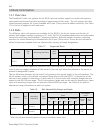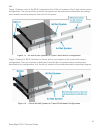
Dell
36
PowerEdge R210 II Technical Guide
10 Embedded NICs/LAN on Motherboard (LOM)
10.1 Overview
The PowerEdge R210 II includes a Broadcom
®
5716C chip embedded on the motherboard. The 5716
chip is connected to the IOH via a PCI Express x4 gen2 link. The 5716 chip provides two 1x Gigabit
Ethernet ports with two RJ-45 connectors on the rear of the system. Other details include:
The firmware for the LOM chip resides in a flash part
The R210 II supports Wake-On-LAN (WOL) from either port
10.2 Features
The Broadcom
®
5716C controller-based LOM supports multiple functions over a unified fabric to help
manage Ethernet, iSCSI and remote management traffic on each port simultaneously. The LOM
provides dual 10/100/1000 Gigabit Ethernet functions, an IEEE 802.3-compliant media access
controller (MAC), and a UTP copper physical layer transceiver solution for high-performance network
applications. The LOM also supports the following functions:
Multiple speed support with dual 10/100/1000-Mbps Ethernet MACs, including half-duplex and
full-duplex capability and a dual 10/100/1000 copper PHY
PCIe compliance with an x4 PCI Express v2.0- and v1.1-compliant bus interface
Diagnostics:
o Link quality indicator LED
o Link speed indicator LED
o Broadcom remote cable management and diagnostics software (Broadcom Advanced
Control Suite [BACS])
o LOM continually monitors various channel conditions
Power management options
Teaming using Broadcom software:
o Support for virtual LANs (VLANs):
Split your physical LAN into logical parts
Create logical segmentation of workgroups
Enforce security policies for each logical segment
o Group multiple network adapters together into teams, providing network load
balancing and fault tolerance functionality
Support for Pre-boot Execution Environment (PXE), iSCSI boot, and Bootstrap Protocol (BootP)
Support for Network Controller Sideband Interface (NC-SI)
IPv4 and IPv6 checksum offload
IPv4 and IPv6 large send offload
Jumbo MTU
LSO and jumbo frames
WOL capabilities
Virtualization functionality
Use of multiple queues


















